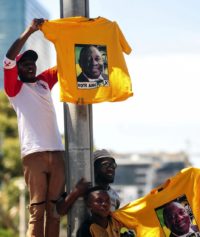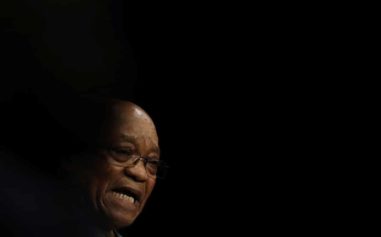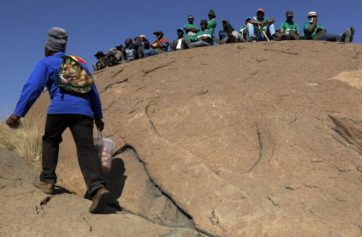In a revelation that could have a devastating impact on the perception of the mine massacre in Marikana, South Africa, a judicial inquiry yesterday heard that 14 of the 34 murdered workers were actually shot in the back—debunking claims by the police that the miners were all charging them.
“All fatal projectile wounds were sustained from the back,” , advocate Dumisa Ntsebeza told the Farlam commission at the Rustenburg Civic Centre, North West.
“Those who were killed were unlawfully killed by SAPS [the SA Police Service],” he said in his opening remarks.
When police opened fire on striking Lonmin mineworkers on August 16, killing 34 nd wounding 78, it changed the trajectory of the entire nation, leading to widespread wildcats strikes in the mining sector, 10 more deaths and a near collapse of the South African economy.
Advocate Ntsebeza represents the Eastern Cape families of 20 of the men who died. At the hearing, the family members, many of the women wearing black and blue mourning clothes, sat in the first two front rows of the auditorium.
Ntsebeza said the police made the erroneous claimed that the mineworkers charged them because they had taken muti (traditional medicine), which made them feel invincible.
“For us, the subtext of this justification… is that the miners, according to them [police], acted like possessed men, that they had to be destroyed like vermin and that they were destroyed like vermin,” he said.
“Whatever the truth of that tragic day, it cannot be that the SAPS could not have acted differently. [They] could and should have brought the gathering to an end peacefully and without loss of life,” Ntsebeza said.
Ntsebeza said his team would make the case that every step the police took leading up to the shooting on August 16 made the workers’ deaths foreseeable and inevitable.
The fallout from the South African mining massacre reached a preposterous level when 270 miners who were jailed during the deadly protest were charged with the murder of their 34 colleagues who were shot by police.
The bizarre decision actually had precedence in South Africa during the apartheid era, when black South Africans were charged with crimes that were committed by others. The state prosecutors in this case used something called the “common purpose” doctrine, which is similar to charging someone for being a member of a mob.
In August, President Jacob Zuma named the judicial commission to conduct a comprehensive inquiry into the clash that resulted in 34 deaths. The commission has the authority to examine the police, the mining company Lonmin, the rival unions, the government and any individuals involved.
“It has been directed to investigate matters of public, national and international concern rising out of the events in Marikana which led to the deaths of approximately 44 people, the injury of more than 70 persons and the arrest of more than 250 people,” Zuma said in televised remarks.
The three-person commission is led by retired appeals court judge Ian Farlam. The commission has four months to complete its investigation and another month to submit a report.


